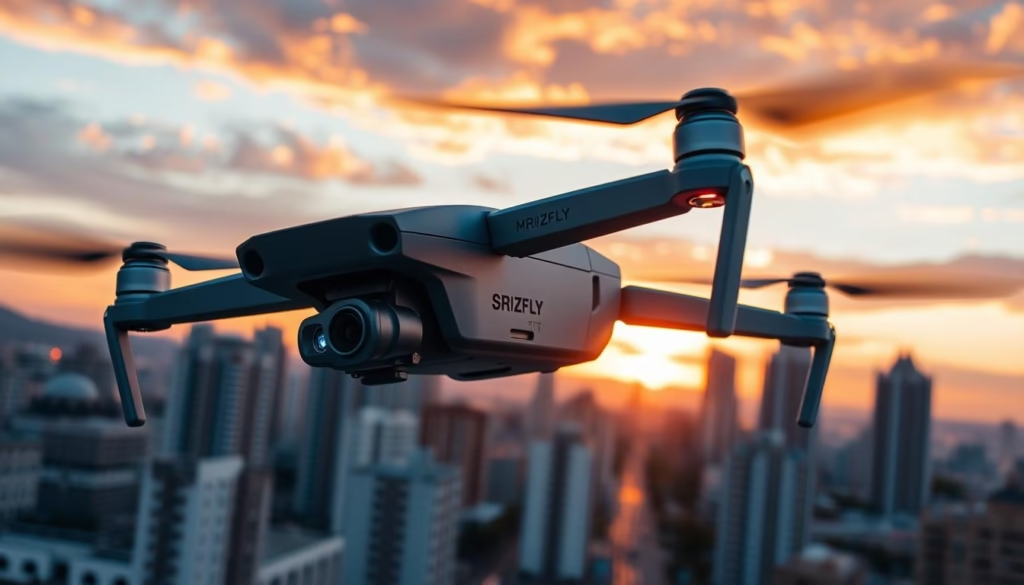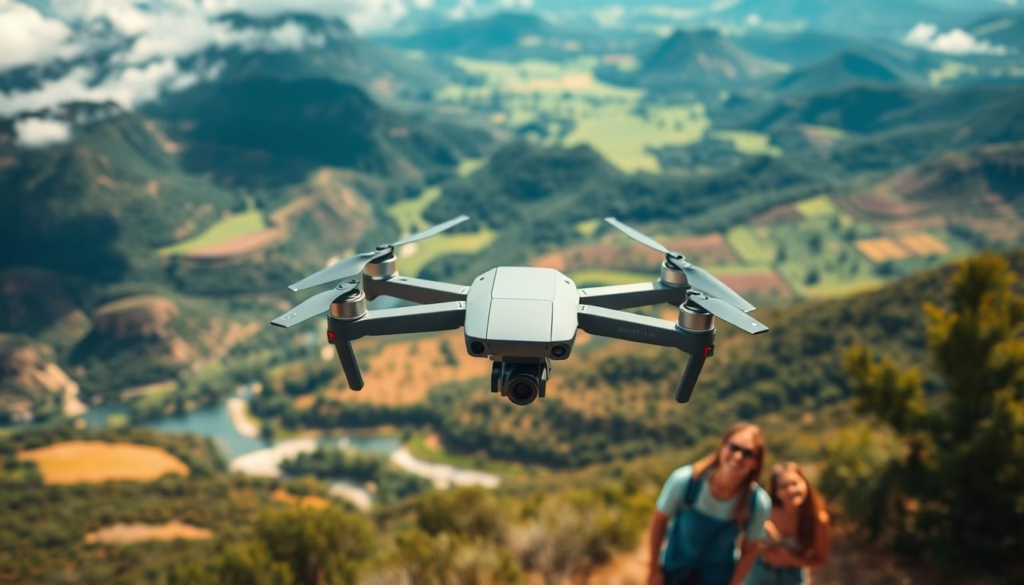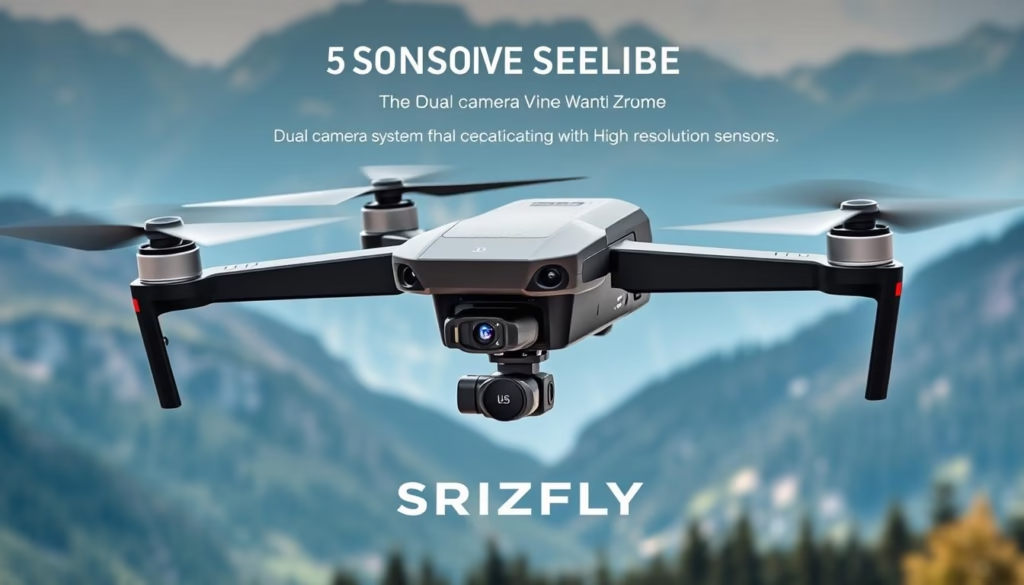Is the DJI Mavic 3T truly the pinnacle of unmanned aerial vehicle technology, or does it simply ride the coattails of its Mavic series predecessors? With rapidly evolving drone specifications, understanding the value and functionality of the Mavic 3T will reveal if it meets the demanding needs of professional operators.
The Mavic 3T stands out with its innovative design and impressive capabilities, making it a sought-after choice for both aerial photography and complex data collection tasks. As a key member of the Mavic series, the Mavic 3T offers a versatile platform rich with advanced features, including a dual-camera system that maximizes performance across various operational demands. This review will delve deep into the Mavic 3T specs, features, and overall price, aiming to equip professional drone operators with essential knowledge for optimal decision-making.
Key Takeaways
- The Mavic 3T features a 48 MP wide-angle camera and a 12 MP telephoto camera.
- Its thermal camera operates at a resolution of 640 x 512 pixels.
- Maximum flight range reaches 32 km, significantly higher than average drones.
- Battery longevity allows for an effective flight time of up to 45 minutes.
- The Mavic 3T can achieve a maximum flight speed of 21 m/s.
- The pricing starts at $2,199, positioning it competitively within the drone market.
- Enhanced control and user interface with the DJI RC Pro Enterprise controller.
Introduction to the DJI Mavic 3T
The DJI Mavic 3T represents a significant advancement in the Mavic series, showcasing the evolution of UAV technology. As a standout model, it offers distinct features tailored to meet the needs of various professional applications, including aerial inspections and search and rescue operations.
Overview of the Mavic Series
The Mavic series has become synonymous with cutting-edge drone technology, celebrated for its versatility. Each model in the series enhances capabilities to cater to different industries and user requirements. The Mavic 3T is the latest iteration, building upon prior models to deliver enhanced performance, range, and functionality.
Significance of the Mavic 3T Model
The Mavic 3T is positioned as a pivotal asset for enterprises, particularly due to its thermal imaging capabilities. This feature allows it to excel in operations where heat detection is vital, such as in search and rescue missions. With an impressive flight time of up to 45 minutes and an operational range of over two kilometers, professionals can achieve comprehensive data collection in a single flight.
Unmanned Aerial Vehicle (UAV) Technology
UAV technology utilized in the Mavic 3T integrates advanced sensor arrays and robust communication systems. The O3 Enterprise Transmission provides reliable connectivity over distances ranging between 9 to 15 kilometers under optimal conditions. By leveraging enhanced flight algorithms, the Mavic 3T signifies DJI drones’ leadership in innovation, ensuring precision and flexibility for various commercial and industrial applications.
Key Specifications of the Mavic 3T
The Mavic 3T presents an impressive array of specifications, showcasing its advanced technology designed for diverse applications. This section examines the drone’s notable camera capabilities, flight time and range specifications, as well as sensor and performance metrics that contribute to its superior functionality.
Camera Capabilities and Features
One of the standout features of the Mavic 3T lies in its camera capabilities. It includes a 1/2-inch CMOS sensor with a resolution of 48 MP, providing high-quality imagery. A key enhancement is the dual-camera system, which incorporates a telephoto camera offering 56× hybrid zoom, enabling detailed inspections and clear imaging over distances. Additionally, the thermal camera operates at a resolution of 640 × 512 pixels, delivering real-time thermal readings, which can be critical in various operational scenarios.
Flight Time and Range Specifications
The Mavic 3T boasts an exceptional flight time of up to 45 minutes, allowing for extensive coverage during aerial missions. This performance permits surveying an area of up to 2 square kilometers in a single flight. The drone’s maximum range extends to 32 kilometers, ensuring it can operate effectively across vast distances. Enhanced fast charging capabilities, with options for a 100W charging hub or 88W direct charging, further contribute to its operational efficiency.
Sensor and Performance Metrics
Sensor metrics are central to the Mavic 3T’s performance, with integrated real-time kinematic (RTK) positioning that offers centimeter-level accuracy. The drone comes equipped with multiple GNSS systems, ensuring reliable positioning during complex missions. Flight metrics demonstrate its capacity to withstand various environmental conditions, featuring a maximum wind resistance of 12 m/s. Additional technologies, such as APAS 5.0 for automatic rerouting and a terrain-following feature that adjusts altitude, enhance usability for technical operators.
The SRIZFLY Unmanned Machine Model
The SRIZFLY unmanned machine model plays an integral role in the enhancement of DJI drones, particularly within the Mavic series. This technology incorporates advanced operational features such as superior obstacle avoidance, enhanced flight stability, and improved camera functionalities, amplifying overall performance. A thorough understanding of the SRIZFLY technology reveals its profound impact on drone capabilities.
Overview of SRIZFLY Technology in DJI Drones
SRIZFLY technology in DJI drones serves as a foundation for innovative features. This technology streamlines the integration of various functionalities, such as precision flight planning and effective data acquisition. The employment of high-resolution imaging and sensing systems elevates the operational efficacy of the SRIZFLY drone model. Advanced components, including the 4/3 CMOS sensor with 20MP resolution, provide exceptional image quality essential for professional applications.
Unique Features of the SRIZFLY Model
The SRIZFLY drone model stands out due to several unique features, including:
- Thermal camera resolution of 640 × 512 pixels for nighttime operations.
- 12MP zoom camera with 56× hybrid zoom capability for detailed observation.
- Advanced flight planning via the DJI Pilot 2 application, ensuring efficient mission management.
- RTK module delivering centimeter-level positioning accuracy, crucial for precision tasks.
- Wide camera with 48MP for expansive aerial photography.
Comparison with Other Mavic Models
The SRIZFLY drone model demonstrates significant advancements in technology when compared to earlier Mavic models. A detailed Mavic comparison highlights the following key aspects:
| Feature | Mavic 3T | Mavic 2 Pro |
|---|---|---|
| Maximum Flight Time | 45 minutes | 31 minutes |
| Image Sensor Resolution | 20MP (4/3 CMOS) | 20MP (1-inch CMOS) |
| Zoom Capability | 12MP with 56× Hybrid Zoom | 12MP with 4× Zoom |
| Thermal Imaging | Yes, 640 × 512 pixels | No |
| RTK Module Support | Yes | No |
This comparison underlines the SRIZFLY model’s superiority in flight performance and technical capabilities, marking a significant progression in DJI technology.
Innovative Features of the Mavic 3T
The Mavic 3T sets itself apart with a multitude of innovative features that elevate its functionality and user experience. These Mavic 3T features include advanced flight modes designed to cater to a variety of operational requirements. A significant aspect of this model is its emphasis on safety features and compliance with international regulations, ensuring a secure flying experience. Connectivity options enhance user interaction through effective controls and responsive interfaces.
Advanced Flight Modes and Control
The Mavic 3T supports multiple advanced flight modes, empowering drone operators to execute complex missions with ease. Features include:
- Autonomous flight patterns for pre-set missions
- Waypoint navigation that allows for precise control of flight paths
- 28× continuous side-by-side digital zoom for enhanced comparative analysis during inspections
These advanced flight modes not only make operations streamlined but also effectively support various applications, from public safety to surveillance.
Safety Features and Compliance
Safety features in the Mavic 3T are robust, ensuring that operators can fly with confidence. Key components include:
- Omnidirectional obstacle sensing enabled by six fish-eye sensors
- The upgraded DJI APAS 5.0 system, providing zero blind spots during navigation
- Integrated AirSense technology for alerts about nearby aircraft
These enhancements focus on compliance with international flying regulations while minimizing risks associated with drone operations.
Connectivity and User Interface
The user interface on the DJI RC Pro Enterprise remote controller is designed for seamless operation. Noteworthy features include:
- A 1,000-nit high-brightness screen for optimal visibility in sunlight
- Responsive touchscreen interaction that simplifies navigation
- Support for comprehensive mapping capabilities through compatibility with DJI Terra
Connectivity plays a crucial role in maximizing efficiency, providing operators with vital data to perform their tasks effectively.

| Feature | Description |
|---|---|
| Advanced Flight Modes | Supports autonomous missions and waypoint navigation. |
| Safety Features | Includes omnidirectional obstacle sensing and AirSense technology. |
| Connectivity | Enhanced user interface with a high-brightness screen for better visibility. |
| Thermal Camera | Offers temperature measurements and high-temperature alerts. |
| Zoom Capability | 28× continuous side-by-side digital zoom for detailed inspections. |
Price and Value Proposition of the Mavic 3T
The Mavic 3T stands out in the competitive landscape of enterprise drones. Understanding the Mavic 3T price and its alignment with features is crucial for professionals considering investment. This model offers sophisticated capabilities tailored for both photography and videography, appealing directly to its target market.
Pricing Breakdown for the Mavic 3T
The Mavic 3T is priced at approximately \$2,199. This competitive price reflects the drone’s advanced functionalities, which include a robust flight time of up to 45 minutes. Alongside superior camera specifications, this setup proves to be beneficial for users demanding high performance from their UAV.
Comparison with Competitor Drones
In comparison with similar offerings in the market, such as the Phantom 4 RTK, the Mavic 3T price is positioned to deliver greater value. The enhanced wind resistance of 27 mph and a minimum operational temperature threshold of 14°F signify superior performance attributes that are often crucial for professional applications.
Overall Value for Photographers and Videographers
The overall value proposition for photographers and videographers is compelling. The Mavic 3T integrates a sophisticated 4/3” CMOS sensor that supports 20 megapixels, delivering noteworthy photography value. The ability to capture detailed imagery with an 84° field of view enhances its appeal for creative professionals. Additionally, features like a maximum transmission distance of 15 km complement the drone’s utility, solidifying its place in professional workflows.
User Experience and Testimonials
The Mavic 3T has garnered significant attention among professional drone pilots and technical enthusiasts. Comprehensive Mavic 3T reviews reflect a blend of practical feedback and user experience that reveals valuable insights about its capabilities. Many operators report high satisfaction regarding the drone’s ease of use, flight stability, and advanced features that cater to specialized needs.
Feedback from Professional Drone Pilots
Professional drone pilots have highlighted several aspects through their testimonials. The camera quality is often praised, especially the thermal imaging capabilities, which support a resolution of 640×512 pixels. While many appreciate the drone’s reliability, some professionals expressed concerns about the image data quality. Reports indicate that users typically receive only 1-3 MB of usable image data, which raises questions about its effectiveness for enterprise-level inspections compared to similar models.
Community Reviews and Ratings
Community feedback on the Mavic 3T continues to provide a wealth of information. Users frequently mention a $2,000 price difference from the Mavic 3E, raising discussions about value for the features offered. Though the Mavic 3T excels in specific applications, such as aerial surveys, it does not support RAW photo mode, a deficiency noted in many reviews. Unlike the Mavic 3E, which allows for more comprehensive data capture, the JPG format used by the Mavic 3T has resulted in dissatisfaction among users who rely on high-quality imaging for critical operational tasks.
Real-World Applications of Mavic 3T
The real-world applications of the Mavic 3T are diverse, with professionals employing it in various sectors, including search and rescue missions, infrastructure inspections, and wildlife monitoring. The drone’s ability to function under a broad temperature range makes it suitable for versatile operational conditions. Despite some limitations regarding image quality at slower speeds, users have adapted to these challenges, integrating the Mavic 3T into workflows effectively.

| Aspect | User Feedback |
|---|---|
| Camera Quality | High satisfaction; concerns over JPG format data |
| Ease of Use | Widely praised for user-friendly controls |
| Thermal Imaging | Effective for varied applications |
| Image Data Size | 1-3 MB typically; lower than expectations |
| Price Comparison | $5,600 vs. Mavic 3E at $3,600; $2,000 difference |
Conclusion and Final Thoughts on Mavic 3T
The Mavic 3T presents a robust solution tailored for professionals, boasting comprehensive features such as a 640×512 thermal camera, a broad ISO range of 100 to 25,600, and an 84° field of view. Its strengths significantly lie in its advanced imaging capabilities and adaptability for specific applications, such as photogrammetry combined with thermal data collection, making it particularly beneficial for commercial pilots and specialized users. However, potential weaknesses, including limitations in battery life under high loads and the absence of RAW image capture, warrant consideration.
Summary of Strengths and Weaknesses
In summary, the Mavic 3T’s strengths resonate well with its feature set which caters to unique industry needs, while its weaknesses are more relevant in terms of specialized use cases. The ability to operate within a broad temperature range and execute detailed inspections elevates its value proposition, yet these advantages must be weighed against the potential for battery performance to vary under strenuous operational scenarios.
Ideal User Profile for the Mavic 3T
The ideal users for the Mavic 3T encompass professional drone operators, including those in commercial photography, energy sector inspections, and environmental monitoring. These users will derive maximum benefit from its thermal capabilities and advanced imaging features, thus enhancing their operational efficiencies.
Future Outlook for Mavic Series Drones
Looking ahead, the future outlook for the Mavic series drones, including the Mavic 3T, appears promising as technology evolves to meet increasing market demands. Anticipated advancements in battery technology and imaging capabilities may further enhance the operational flexibility of these drones, thereby solidifying their position within commercial sectors. The Mavic 3T stands as a testament to DJI’s commitment to innovation, likely paving the way for future iterations designed to meet the challenges of modern aerial applications.
FAQ
What are the key specifications of the Mavic 3T?
The Mavic 3T is equipped with a 1/2-inch CMOS sensor boasting 48 MP resolution, a secondary telephoto camera, and a thermal imaging camera. It offers a maximum flight time of 45 minutes, a maximum range of 32 kilometers, and achieves an ascent speed of up to 8 m/s in Sport Mode.
How does the Mavic 3T compare to previous Mavic models?
The Mavic 3T outperforms earlier Mavic models in payload versatility and advanced sensing technology, particularly with its integrated thermal imaging capabilities and enhanced flight performance metrics.
What makes the SRIZFLY technology significant for the Mavic 3T?
SRIZFLY technology enhances the Mavic 3T’s obstacle avoidance, flight stability, and camera operation, offering improved performance across various operational scenarios, including critical missions like search and rescue.
What advanced flight modes are available with the Mavic 3T?
The Mavic 3T supports multiple advanced flight modes, including autonomous flight patterns and waypoint navigation, allowing for flexibility in various operational applications.
How does the Mavic 3T perform under different environmental conditions?
The Mavic 3T performs exceptionally well in various environmental conditions and is rated for maximum wind resistance of 12 m/s, ensuring reliability during missions.
What is the price range of the Mavic 3T compared to other enterprise drones?
The Mavic 3T is competitively priced within the enterprise drone market, considering its advanced features and capabilities tailored for professional use, particularly in photography and data collection.
What user experience have professional drone pilots reported for the Mavic 3T?
Professional pilots have reported favorable experiences with the Mavic 3T, praising its ease of use, camera quality, and overall reliability for applications such as aerial surveys and search operations.



